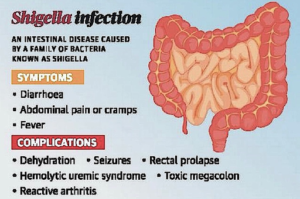In news– Recently, the Kerala health department has identified Shigella bacteria as the cause for the food poisoning incident in Kasaragod, which claimed the life of a 16-year-old girl and led to 30-odd others being admitted to hospital.
What is Shigella bacteria?
- Shigella is a bacterium that belongs to the enterobacter family, a group of bacteria that reside in the intestine, not all of which cause disease in humans.
- It mainly affects the intestine and results in diarrhoea, sometimes bloody, stomach pain, and fever.
- The infection spreads easily as it takes only a small number of bacteria to make someone ill.
- It is a food- and water-borne infection, and can happen when someone consumes contaminated food.
- The disease is easily spread by direct or indirect contact with the excrement of the patient.
- One can get the infection if he/she swims or takes a bath in contaminated water.
- Infections like typhoid and cholera are also because of contaminated foods.
- Shigella outbreaks appear to be exacerbated during pregnancy and in children under five years of age, and in those with weakened immune systems.
- There are four types of Shigella bacteria that affect humans, they are:
- Shigella sonnei.
- Shigella flexneri.
- Shigella boydii.
- Shigella dysenteriae.
- The fourth type causes the most severe disease because of the toxin it produces.
- Infection does not generally kill, unless the patient has a weak immune system or the pathogen is resistant to the antibiotics that are prescribed.
- If the bacteria continue to proliferate in the body even after giving the antibiotics, it will continue to produce toxins, which can then affect the kidney, cause seizures, lead to multi-organ failure, and shock, and even turn fatal.

- The mortality of the infection is less than 1%.
- The measures to prevent a Shigella infection are the same as that of any other food- and water-borne infection.
Source: The Indian Express
















